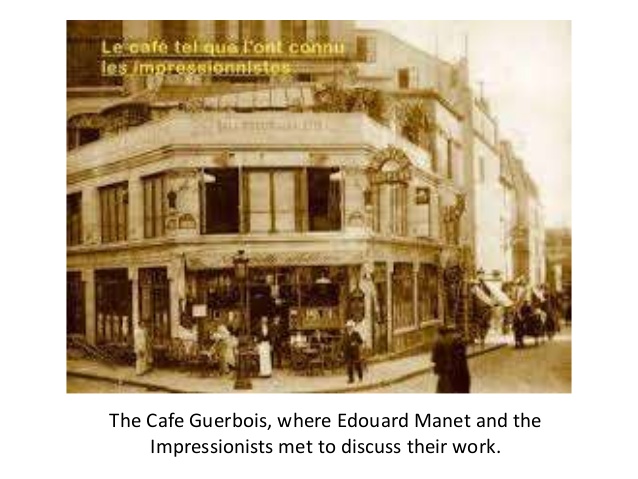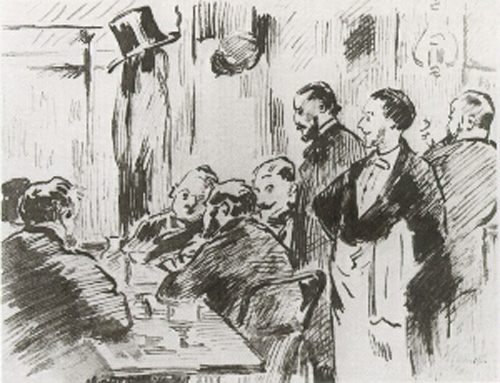The Café
 His
[Zola's] life
shifted
increasingly
toward the
Right Bank
now that
he saw
more and
more painters
who
inhabited
Les Batignolles.
Linked to
central Paris by
omnibuses called
"Batignollaises," this
urban village,
where
cottages
survived among
recently built
tenements, became
home for
people needing
cheap digs
or wanting
asylum from
revolutionary turmoil.
Its population
had swelled
after 1848
and continued
to
swell
under
Napoleon III,
when widespread
demolition of
slums cast
thousands
adrift.
Pensioned
civil
servants,
retired
shopkeepers,
downat-heel
spinsters,
and
unemployed workers
made do
in an
environment that
also proved
hospitable to
young
artists.
Manet lived
on the
rue de
Saint-Petersbourg (later
renamed Leningrad);
within hailing
distance
of
him
were
Bazille,
Sisley, Renoir,
and
Degas.In
1867, Zola,
too, found
quarters in
Les Batignolles.
Meanwhile he
showed up
almost
every
week
at
a
cafe
just
off the
Place de
Clichy
where
he
was
sure
to
find his
painter friends
assembled,
especially
on Friday
afternoons, when
they met
in plenary
session, knowing
that
Manet
would
join
them. Until
Manet
"discovered"
it,
nothing distinguished
the
Cafe Guerbois
except its
trellised
garden.
Most habitues
came for
sport, and
billiard balls
colliding on
tables in
a dimly
lit back
room echoed
through the
saloon, which
had mirrors
and gingerbread
to remind
Manet of
his beloved
Boulevard. Here
he matched
wits with Degas
while
neighborhood
folk,
perplexed
by
their
conversation,
looked sideways
at what
they called
"the artists'
comer."
It
was
a lively
scene, if
not
bohemian
in
the
way
that
the
Cafe
Momus
had
been
when Charles
Baudelaire,
Gustave
Courbet,
and
Gerard
de
Nerval
gathered there
during the
1840s.
As Monet
remembered
years
later:
His
[Zola's] life
shifted
increasingly
toward the
Right Bank
now that
he saw
more and
more painters
who
inhabited
Les Batignolles.
Linked to
central Paris by
omnibuses called
"Batignollaises," this
urban village,
where
cottages
survived among
recently built
tenements, became
home for
people needing
cheap digs
or wanting
asylum from
revolutionary turmoil.
Its population
had swelled
after 1848
and continued
to
swell
under
Napoleon III,
when widespread
demolition of
slums cast
thousands
adrift.
Pensioned
civil
servants,
retired
shopkeepers,
downat-heel
spinsters,
and
unemployed workers
made do
in an
environment that
also proved
hospitable to
young
artists.
Manet lived
on the
rue de
Saint-Petersbourg (later
renamed Leningrad);
within hailing
distance
of
him
were
Bazille,
Sisley, Renoir,
and
Degas.In
1867, Zola,
too, found
quarters in
Les Batignolles.
Meanwhile he
showed up
almost
every
week
at
a
cafe
just
off the
Place de
Clichy
where
he
was
sure
to
find his
painter friends
assembled,
especially
on Friday
afternoons, when
they met
in plenary
session, knowing
that
Manet
would
join
them. Until
Manet
"discovered"
it,
nothing distinguished
the
Cafe Guerbois
except its
trellised
garden.
Most habitues
came for
sport, and
billiard balls
colliding on
tables in
a dimly
lit back
room echoed
through the
saloon, which
had mirrors
and gingerbread
to remind
Manet of
his beloved
Boulevard. Here
he matched
wits with Degas
while
neighborhood
folk,
perplexed
by
their
conversation,
looked sideways
at what
they called
"the artists'
comer."
It
was
a lively
scene, if
not
bohemian
in
the
way
that
the
Cafe
Momus
had
been
when Charles
Baudelaire,
Gustave
Courbet,
and
Gerard
de
Nerval
gathered there
during the
1840s.
As Monet
remembered
years
later:
 Edouard Manet, The Café |